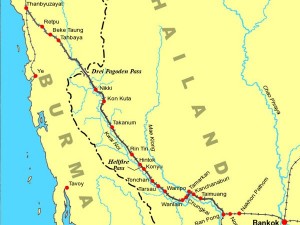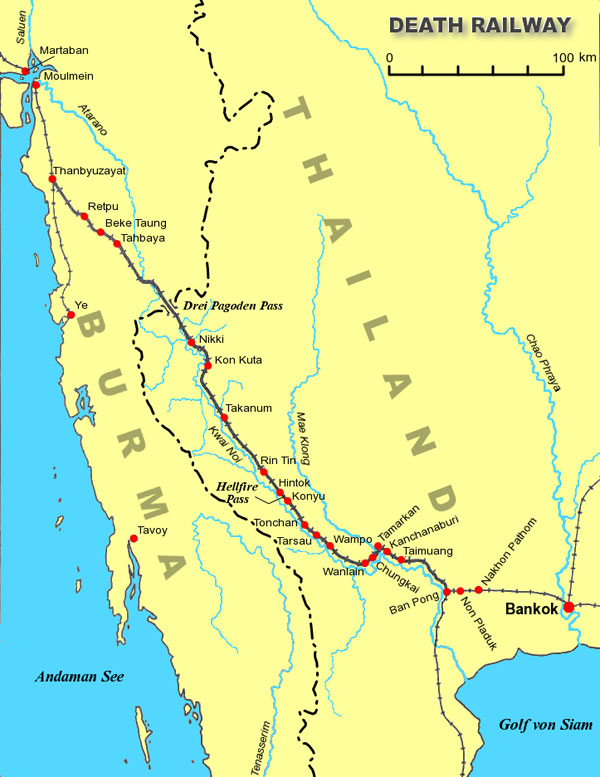 In a plan to attract tourists and boost trade with Thailand, Burma plans to restore a 150-mile section of the “Death Railway,” infamous during World War II. The occupying Japanese army used prisoners of war and Asian labourers to constructed the railway. Tens of thousands prisoners were forced to work in inhuman conditions to build the 424-kilometre railway through dense jungles and mountains. The railway connected Bangkok, Thailand, and Rangoon. According to histories of the railway, about 180,000 Asian labourers and 60,000 Allied prisoners of war worked on the railway during its construction. Of these, around 90,000 Asian labourers and 16,000 Allied POWs died as a direct result of the project, according to some historians. The dead POWs included 6,318 British personnel, 2,815 Australians, 2,490 Dutch, about 356 Americans and a smaller number of Canadians and New Zealanders. The most famous portion of the railway was Bridge 277, “the bridge over the River Kwai,” in the Thailand section of the railway in Kachanaburi, which is today a popular tourist area. The construction of the bridge was a major plot feature in the book by Pierre Boulle and the film based on it, The Bridge on the River Kwai. The restored rail section will run from Burma’s Three Pagodas Pass area to Thailand, said railway minister Aung Min. “We will reopen this (rail)road,” he was quoted as saying by local media. “The other countries said they would also help us, and we will continue working for it. We will do a survey and try to start work after the rainy season with the help of the international community.” The railway could be expected to attract great interest of Western tourists and others and provide a much-needed economic boost for the impoverished area, which is home to Burma’s Karen ethnic group. Karen rebels signed a cease-fire with the government in January, a major breakthrough towards ending the long-running insurgency. Source: http://www.mizzima.com/edop/features/7153-burma-to-rebuild-death-railway.html
In a plan to attract tourists and boost trade with Thailand, Burma plans to restore a 150-mile section of the “Death Railway,” infamous during World War II. The occupying Japanese army used prisoners of war and Asian labourers to constructed the railway. Tens of thousands prisoners were forced to work in inhuman conditions to build the 424-kilometre railway through dense jungles and mountains. The railway connected Bangkok, Thailand, and Rangoon. According to histories of the railway, about 180,000 Asian labourers and 60,000 Allied prisoners of war worked on the railway during its construction. Of these, around 90,000 Asian labourers and 16,000 Allied POWs died as a direct result of the project, according to some historians. The dead POWs included 6,318 British personnel, 2,815 Australians, 2,490 Dutch, about 356 Americans and a smaller number of Canadians and New Zealanders. The most famous portion of the railway was Bridge 277, “the bridge over the River Kwai,” in the Thailand section of the railway in Kachanaburi, which is today a popular tourist area. The construction of the bridge was a major plot feature in the book by Pierre Boulle and the film based on it, The Bridge on the River Kwai. The restored rail section will run from Burma’s Three Pagodas Pass area to Thailand, said railway minister Aung Min. “We will reopen this (rail)road,” he was quoted as saying by local media. “The other countries said they would also help us, and we will continue working for it. We will do a survey and try to start work after the rainy season with the help of the international community.” The railway could be expected to attract great interest of Western tourists and others and provide a much-needed economic boost for the impoverished area, which is home to Burma’s Karen ethnic group. Karen rebels signed a cease-fire with the government in January, a major breakthrough towards ending the long-running insurgency. Source: http://www.mizzima.com/edop/features/7153-burma-to-rebuild-death-railway.html

My father was a survivor of this ‘Railway of Death’ as it became known. If you want to understand the horrors and misery the prisoners were forced to suffer, you should read “And The Dawn Came Up Like Thunder” by Leo Rawlings who was also a POW on that railway. The book contains many sketches by Mr Rawlings depicting the appalling physical conditions of the men, not like the overweight actors in subsequent films. I do not believe that making money from tourists out of the sufferings of these brave men is morally acceptable. Monuments in their honour, yes.